
- Index
- Brand
- Features
- Black Ip Finish (5)
- Black Trim (6)
- Chrome Plated Finish (10)
- Chrome Trim (222)
- Gold Trim (789)
- Gunmetal Trim (6)
- Ip Finish (6)
- Kaga Hira Maki-e (5)
- Meisterstuck (3)
- Pink Gold Trim (4)
- Platinum Trim (8)
- Plunger Type (4)
- Polished (5)
- Ready To Write (6)
- Rhodium Finish (16)
- Rose Gold Trim (6)
- Silver (4)
- Silver Trim (8)
- Sterling Silver Trim (6)
- Vanishing Point (10)
- Other (2487)
- Material
- Nib Material
- 14 Kt Gold Plated (4)
- 14k (16)
- 18k Gold (7)
- 21 Gold, Large (6)
- 21k (5)
- 21k (bicolor Finish) (4)
- 21k Standard Size (4)
- 21k, Black Ip Finish (8)
- Gold (12)
- Gold Plated (13)
- Gold, 14c (7)
- Gold, 14k (801)
- Gold, 14k (no.15) (4)
- Gold, 18c (6)
- Gold, 18k (525)
- Gold, 21k (35)
- Iridium (9)
- Stainless Steel (537)
- Steel Nib (4)
- Unknown (4)
- Other (1605)
- Nib Size
- Bold (5)
- Broad (9)
- Broad (b) (156)
- Ef, F, M Or B (15)
- Ef, F, M, B, (25)
- Extra Fine (7)
- Extra Fine (ef) (161)
- F Or M (8)
- Falcon (fa) (9)
- Fine (9)
- Fine (f) (647)
- Fine Medium (fm) (11)
- Medium (42)
- Medium (m) (988)
- Medium Fine (mf) (23)
- Music (5)
- Music (ms) (11)
- Soft Fine (sf) (18)
- Stub (17)
- Unknown (8)
- Other (1442)
- Type
Wancher Fountain Pen Sekai Kaba Zaiku Yamazakura, Calligraphy Pen
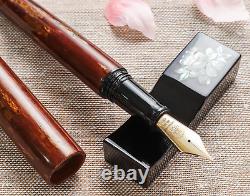
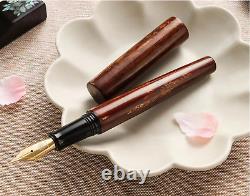

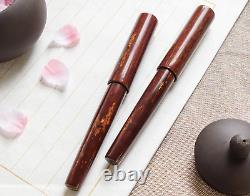
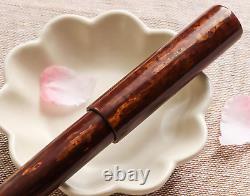
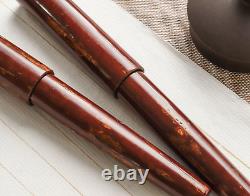
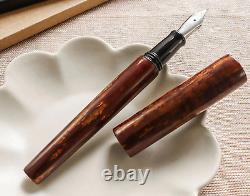
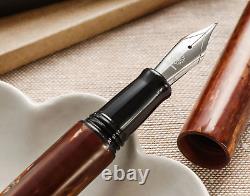
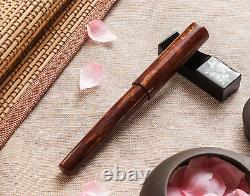


Born from the nature - Unique in every way. The Kaba Zaiku art can be dated back to around 200 years ago, in Kakunodate, Akita - known as "the forest kingdom" and also, one of the snowiest regions in Japan. As such, the Wild Cherry Tree Bark cultivated in Kakunodate and used in the Kaba Zaiku technique also possesses outstanding characteristics: a robust vitality and strength that has endured years of freezing winter and has been polished by wind, rain, and snow.
It is also known to be superior in terms of moisture/dryness proof and durability, which makes it a perfect material to create long-lasting craftworks. The crafting of Kaba Zaiku. The Kaba Zaiku art requires the delicate and highest skills to transform the rough and uneven bark of cherry trees into wood sheets that are firm and elastic enough for use. Traditional Kaba Zaiku craftwork is usually limited to certain objects with a relatively large surface like tea holders, plates, or boxes. Yet this time, we have challenged ourselves to an unfamiliar shape - a fountain pen.
And, to accomplish this mission, Wancher has collaborated with most experienced artisans from Yatsuyanagi Co Ltd, and created a new model that presents this beautiful art - Sekai Kaba Zaiku - Yamazakura. There are crucial main steps of Kaba Zaiku to create Sekai Kaba Zaiku fountain pen: "Kaba-kezuri" (scraping of bark), "Nikawanuri" (gluing with special glue Nikawa), "Dobari" (adjusting with heat), and "Shi-age" (polishing). Even after the product is completed, the finish of Kaba Zaiku will continue to age. The more you use it, the more lustrous a Kaba Zaiku fountain pen will grow, making it your treasure artwork for many generations to come.A fountain pen to cherish and grow. Kaba Zaiku is born with our motivation to preserve traditional craftsmanship and add cultural value to your everyday objects.
It is also a sustainable art where the material - cherry tree bark - can regrow in five years, and the gluing Nikawa is an environmental-friendly material. Holding a Kaba Zaiku pen in your palm, you can enjoy the beauty of an one-of-a-kind artwork, and feel the warmth of nature with every words you write. At the same time, each KabaZaiku pen crafted will help the artisans of Kakunodate to continue their passion and pass down this unique traditinal art to the future generations.As real wild cherry tree bark is used, the patterns and personality on the pen will vary from piece to piece. The pen you received might have a slightly different pattern from the pictures here.
The name "Kaba Zaiku" can be confusing to some because the actual material used is Cherry Tree Bark, not Birch Bark (Kaba). The origin of the technique name can be explained in many ways, one of which is that "Kaba" is an old word referring to "Mountain/Wild Cherry Tree". Material & art: Natural Wood, Cherry Tree Bark.
Filling mechanism: Converter or Cartridge (European International Standard). Nib: #6 Jowo stainless steel.Feed: Plastic, ebonite black, ebonite red. Traditional Japanese Wooden Box + Pen Kimono + Instructional Materials + Certificate + Converter + Cartridge. Note: Kaba Zaiku fountain pen uses authentic wood bark from real Japanese wild cherry trees. Therefore, you might observe a few small wood schemas on the finish. These are all natural traits and unique characteristic of the material, and considered Wabi-sabi (perfect imperfections).
Please do not mistake it as defects.
